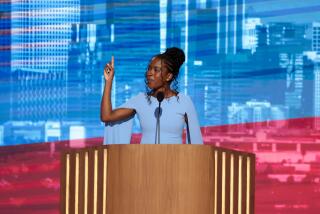Dana Goodyear wouldnât introduce herself as a poet
Poet and journalist Dana Goodyear perches on a swivel chair in the second-floor writing studio behind her Venice home, the windows cranked open to a gentle ocean breeze. Low rooftops and tall palm trees stretch to the horizon, and Goodyear points to an anomaly just across the alley â a faded surfboard tossed up and forgotten atop a neighborâs single-story house.
Such juxtapositions appeal to Goodyear, a New Yorker magazine staff writer. And while the misplaced surfboard doesnât make an appearance in her new book of poems, âThe Oracle of Hollywood Boulevardâ (Norton, $25.95), it reflects the kind of unexpected encounters that she says drives her poetry.
âThereâs something about the shape that a poem takes in my mind before I write it that has to do with suddenness,â Goodyear says. She finds itâs more effective to deal with that immediacy in poems than in her better-known nonfiction magazine pieces, which she describes as âmore outside and objective. For me, it makes sense to address shocking experiences through poems because of the way poems also have that effect on the reader.â
Itâs a radically different form of writing from her usual journalism and occasional criticism for the New Yorker, where Goodyear started as an editorial assistant in 1999 and eventually worked her way up both editing and writing for the magazine. Sheâs been writing from and about Los Angeles since moving here in 2007. She also teaches in USCâs Master of Professional Writing program and is co-founder of Figment, an online community of readers and writers of young-adult fiction.
In some ways, Goodyearâs career has evolved more by happenstance than careful plotting. Goodyear studied English at Yale and briefly contemplated an academic career as a platform for writing poetry but moved instead into journalism.
âI was terrified of taking the GREâ to qualify for graduate school, she says. After working or interning at Publishers Weekly, the Paris Review and as âthe book reviewer for Pool and Spa Living, which is not a magazine that anybody has even ever heard of,â she says, Goodyear landed at the New Yorker when a friend who worked there told her one of the editors was looking for an assistant. None of her jobs, she notes, had anything to do with poetry, which she continued to write on the side.
âI donât think that I ever believed that poetry would be a career,â Goodyear says. âI have always thought of poems as something more private than professional.... I would never introduce myself as a poet. I will always have some other thing that I am.â
Yet poet she is, with pieces published in the New Yorker, the Paris Review and the New American Poetry Review, among other outlets. âThe Oracle of Hollywood Boulevardâ is her second published collection, after the critically acclaimed âHoney and Junk: Poems,â which came out in 2006. Sheâs also at work on her first nonfiction book about American foodie culture, which is due to her publisher this winter.
Where Goodyearâs narrative style takes time to unroll, her poems are terse and framed with a sharp immediacy. Most of the poems are brief, distilled to the core, as in this section of the poem âFrom Lifeâ as two friends walk in Los Angeles: ââWhat is shocking in art?â my friend asks â not sex./ we agree, not any more, then stop before a rubbery/ gray tail leading from a mound of dust:/ a few coarse hairs swept into a pile, a gnarl of foot,/ no meat, no bones, no face. No, not even this.â
The product of a broken marriage, Goodyearâs early life was itinerant, ranging from London to Hong Kong with lengthy U.S. stays in between. The move to Los Angeles was the most jarring of them all, she says, and âThe Oracle of Hollywood Boulevardâ draws from her difficulties in wrapping her mind around her new city, and her new life as a wife (her husband is developer Billy Lehman) and now mother of two children younger than 3.
âThe poems are very much engaged with dealing with a new landscape, apprehending a new environment, getting my bearings,â Goodyear says. The work shares some of the internal mechanisms of the poems in âHoney and Junkâ but have a more defined sense of place. âYou would never say the poems of the first book are poems of New York, but most were written there.â The new ones, though, are set against âthis sort of deteriorating beautiful, quasi-natural, quasi-artificial landscape that is modern contemporary Los Angeles.â
Yet the landscape is more stage than point of contemplation, as in the poem âConception.â
This time of year the snakes leave their old skins
hanging in the Meyer lemon tree â
Afterbirth, carcass, or nude hose.
âChoose lifeâ says the hand-drawn sign
at the edge of the almond-pale, crystal-pink grove
on Interstate 5.
A poll of teenagers in Hollywood asks:
âWhat is the opposite of youth?â
Overwhelmingly, they answer âdeath.â
Ultimately, Goodyear says, she tries in her poems to âcome to terms with some of the basic forces of nature that all human beings try to come to terms with. Poems about decay and regeneration, and birth and death â a lot of the paired opposites that people write poems about.â
Irvine-based writer Martelle is the author, most recently, of âDetroit: A Biography.â
More to Read
Sign up for our Book Club newsletter
Get the latest news, events and more from the Los Angeles Times Book Club, and help us get L.A. reading and talking.
You may occasionally receive promotional content from the Los Angeles Times.









